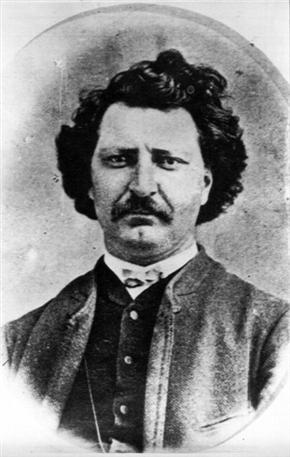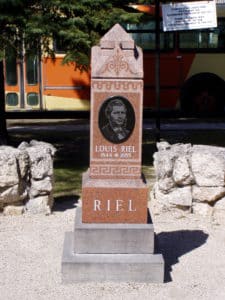Louis Riel was born on October 22, 1844 in Saint-Boniface to his parents, Louis Riel Sr. and Julie Lagimodiere. He was the  oldest out of the eleven children. His father was of Franco-Ojibwa Metis decent and his mother was one of the early white settlers. The family spent a fair amount of their time at the Roman Catholic Church, so eventually Riel was interested in studying priesthood. After his father died, Louis lost interest in his studies and tried studying law instead. During this time, he fell in love with Marie-Julie Laflamme. Her father did not approve of her marrying a man of Metis descent, so they were forced to split.
oldest out of the eleven children. His father was of Franco-Ojibwa Metis decent and his mother was one of the early white settlers. The family spent a fair amount of their time at the Roman Catholic Church, so eventually Riel was interested in studying priesthood. After his father died, Louis lost interest in his studies and tried studying law instead. During this time, he fell in love with Marie-Julie Laflamme. Her father did not approve of her marrying a man of Metis descent, so they were forced to split.
In 1869, the Hudson’s Bay Company sold Rupert’s Land and the North-Western Territory to the Dominion of Canada. William McDougall was then appointed lieutenant-governor and survey crews were sent to Red River. The Metis National Committee was formed to protect their status against Protestant immigrants from Ontario. Riel was the secretary and then got elected to be the president of the committee. Land surveys were halted and William McDougall was unable to enter the Red River Settlement. Upper Fort Garry was detained from the Hudson’s Bay Company and there was an extension to Canadian authority in the Northwest.
The Declaration of the People of Rupert’s Land and the North-West was issued in December. This rejected Canada’s authority to control the Northwest and to help with the settlement between Canada and the provisional government. Later the convention was changed into the Provisional Government of Assiniboia. This consisted of an elected legislature, someone responsible for the legislature, and a judicial branch.
At Portage la Prairie, armed Canadians frightened the Metis people and many of them were imprisoned. Thomas Scott, from the Orange Lodge, was executed by a firing squad. This led to a new agreement in the Manitoba Act. The federal government agreed to save 1.4 million acres for the Metis children of Manitoba. The province would then be officially bilingual.
The Red River Expedition was not part of the agreement made, so Riel was frightened. He fled to the United States. Later, he returned back to Saint-Vital, Red River and tried to organize a new force of Metis. Their goal was to prove the Metis were committed to their agreement.
Louis was Thomas Scott’s murderer according to Ontario. They made it so there was a five thousand dollar reward for Riel’s arrest. Quebec on the other hand, treated him like their hero. He stayed faithful to his Roman Catholic and French background in Manitoba. Sir John A. Macdonald tried to keep Riel in voluntary exile in the United States by paying cash. The exile only lasted for four months. He then entered federal politics and was elected in the federal riding of Provencher. After he was re-elected, he travelled to Ottawa. There he signed the register at the House of Commons. He was later was expelled from the house.
Louis Riel had a nervous breakdown and he was taken to the hospital at Longue Pointe without his knowledge. Later he was moved to the asylum at Beauport. Because he was recovering, he connected with the Metis again and joined the Republican Party. He was then an American citizen and he married a fellow Metis woman, Marguerite Monet. After the marriage, in 1883 he became a schoolteacher at Saint Peter’s Mission.
Riel was asked to travel north to deal with Canadians for the Metis people. Gabriel Dumont was the man who asked the favor because he was concerned about their legal rights. Riel and his family went to Batoche and he
made peace there and prepared a request. The Metis people were worried about their land because technically, it wasn’t theirs. The Non-Aboriginals were also unhappy with their land, so they voiced how they felt.
After the NWMP was established in 1885, the Metis had a meeting to discuss their land rights. Riel came to the idea that a provisional government for Saskatchewan would be a wise choice. Unfortunately, his idea was turned down. Instead, the Revolutionary Bill of Rights was constructed. This insured that the Metis people finally had land possession.
Louis was the president of the provisional government at Batoche. He tried to force the Hudson’s Bay Company to surrender at Fort Carlton. The Metis were unsuccessful for a change because of the small population of the group. Riel had to surrender himself to the Canadian Military.
On July 20, 1885, Riel’s trial was in Regina because he was facing a charge of treason. Many people pointed out his insanity because of his breakdowns and his time spent in asylums. Although it was a tough fight, Louis tried his hardest to defend himself and his fellow Metis people. He felt as if their actions were justifiable and his powerful speech proved that he wasn’t as insane as everyone thought. Sadly, because he was no longer “insane,” it meant that he would have to hang.
Riel was hung on November 16, 1885 in Regina. His remains were transported to Saint-Boniface and was taken to a cemetery at the cathedral. It is often debated whether or not Riel was a hero or a traitor.

